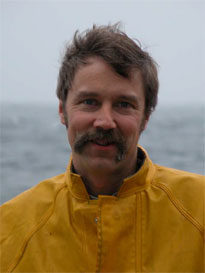OOI Mapping Cruise 2008
Going to Sea
My first job at sea was on a German freighter transiting across the Atlantic Ocean. I was six years old, and my family was returning to the United States after a European vacation. My father, who had been a merchant sailor and knew the ropes, went down to the waterfront and negotiated our passage with the captain of a ship bound for New York. We were the only passengers onboard. Passengers! There are no passengers on a working ship! After the freighter got underway my dad talked to the “Boatswain,” the head of the deck crew, who set me up with paint-scraping tools and some primer. For one very memorable day I worked as a deck sailor on a real freighter at sea. The Boatswain said that I did a good job. Many books and sea stories later I joined the U. S. Coast Guard and served for seven years on three different oceangoing cutters and a rescue station. When my enlistment was up I finally returned to the merchant marine career that I had started so young and sailed from San Francisco to Hawaii on a rusty old “tramp” freighter.
Later, I fished a season in southeast Alaska on my dad’s wooden 46-foot commercial troller, catching salmon using hook and line trailing from two tall trolling poles. I remember the hard work, the long hours, and the beautiful pristine Alaskan wilderness. On one evening, after a long day, we anchored in a tiny little bay. The air was crisp, the water was still, and the ‘quiet’ profound as two exhausted fisherman bobbed gently, listening to the occasional breath of an orca whale as is trolled for its own fish in the bay with us.
Oceanographic Research Ships
After finishing my Bachelor of Science degree in oceanography at the University of Washington, I began working for John Delaney and Debbie Kelley at the School of Oceanography. Now, every summer, I go to sea on research ships as an oceanographer. These ships are a far cry from the old merchant tramp that I sailed on. The R/V Thompson has three massive 1,500-kilowatt generators that provide the power for two 3,000 horsepower “azimuth stern thrusters” that can each rotate through 360 degrees. The stern thrusters. plus a 1,100 horsepower water jet bow thruster, make the ship incredibly maneuverable. The Thompson also has a “dynamic positioning system” that takes GPS input and controls the ship’s movement and orientation.
On Sunday we towed an underwater camera system on a steel-encased conducting cable and captured digital images of the seafloor. The camera, which was dangling three kilometers beneath the ocean surface, was towed up the steep continental slope as a winch operator kept the camera package an unnerving three to five meters above the seafloor. The ship, controlled by the dynamic positioning system, moved sideways at half of a mile per hour, keeping the rear end, or stern, to the wind.
Swath Sonar
On this cruise I am learning more about the Thompson’s swath sonar system. The ship uses a Kongsberg Simrad EM300 multibeam echo sounder to acquire bathymetric data. An array of 135 sound-pulse beams are transmitted in a fan pattern from port to starboard as the ship steams ahead at around nine miles per hour. To maintain the proper signal-return strength and resolution, the sonar control system automatically adjusts the spread of the ‘fan’ to a wider or narrower angle as the water depth below the array increases and decreases. The ship’s marine technicians keep the sophisticated system running smoothly and pass the raw data to scientists in the main lab who “clean” it, removing bad data points or “outliers,” and produce wonderful three-dimensional maps of the seafloor. I have been taking these processed digital maps and converting them into a form that can be taken into a powerful mapping software called ArcGIS and into “COVE,” the new Google-Earth-like software that is being developed by Keith Grochow for the Regional Scale Nodes component of the OOI.
If all this isn’t “high-tech” enough, take a version of that complex sonar system and put it on an autonomous robot submarine that can be deployed to run a survey of the seafloor along a pre-programmed grid pattern while deep beneath the sea surface and completely separated from the ship.
These wonders amaze and intrigue me but I still enjoy the low-tech and timeless aspects of going to sea: The mooring lines, the deck cleats and small boats; the familiar routines of the ship’s crew going on around me. One of the crew I had sailed with as an “Able Seaman” on that old tramp cargo ship some years ago. I feel connected to my past seagoing experiences while, at the same time, entrenched in my scientific pursuits.
Related Content
Voices
- Newbies, Oldies and 21st Century Oceanography
- Going to Sea
- Once and Future Oceanographer
- The Oceans: Medicine Chest for the World
- When Your Home Bobs
- Seas of Opportunity
- Voices of the Fishes
- Oceanography as an Opportunity to Contribute
- The Water Column
- Ocean Heritage Guides this Oceanography Major
- Theater in the Round
